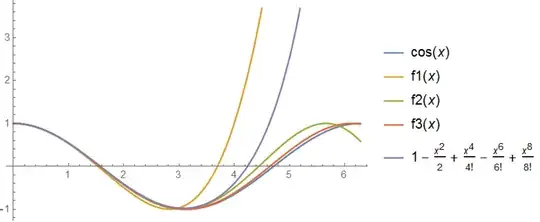I usually don't see any expressions for approximate calculation of trigonometric functions aside from their Taylor series.
But Taylor series work better for small angles, so in general they are not the best way to calculate these functions.
But there is another obvious way to approximate $\cos(x)$:
$$ \cos(x)=2\cos^2\left(\frac{x}{2}\right)-1=2\left(2 \cos^2\left(\frac{x}{4}\right)-1 \right)^2-1=\dots $$
Soon enough we get to small angles, and we can use the first two terms of Taylor series:
$$ \cos\left(\frac{x}{2^n}\right) \approx 1-\frac{x^2}{2^{2n+1}} $$
We obtain the following sequence of approximations to $\cos(x)$:
$$ f_1(x)=2\left(1-\frac{x^2}{2^{3}}\right)^2-1 $$
$$ f_2(x)=2\left(2\left(1-\frac{x^2}{2^{5}}\right)^2-1\right)^2-1 $$
$$ f_3(x)=2\left(2\left(2\left(1-\frac{x^2}{2^{7}}\right)^2-1\right)^2-1\right)^2-1 $$
For the angles in the range $0<x<\frac{\pi}{2}$ Taylor expansion of the same order fits better. On the other hand, for larger angles this method is superior, as you can see from the graphs.
So, is this method widely known? Can it be useful for calculating trig functions in some cases?
I want to also stress, that while $\cos(x)$ is periodic and we don't need to calculate it for large $x$, the same method can be used to calculate $\cosh(x)$ (the only change will be the sign before $\frac{x^2}{2^{2n+1}}$).
We can use it to calculate the number $e$, with the relation:
$$e=\cosh(1)+\sqrt{\cosh^2(1)-1}$$
Do[A0 = 1 + 1/2^{2 n + 1};
Do[A1 = 2*A0^2 - 1;
A0 = N[A1, 47], {j, 1, n}];
Print[n, " ", N[A0 + Sqrt[A0^2 - 1], 17]], {n, 1, 14}]
At $14$ recursion steps we obtain the following value for $e$, correct to 9 digits:
$$e=2.718281828...$$
